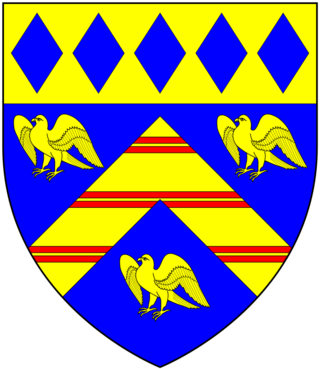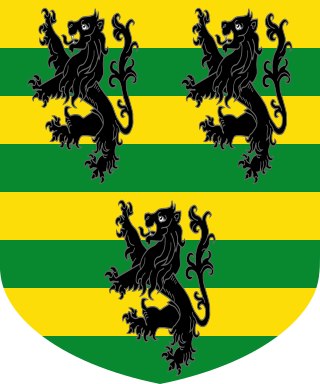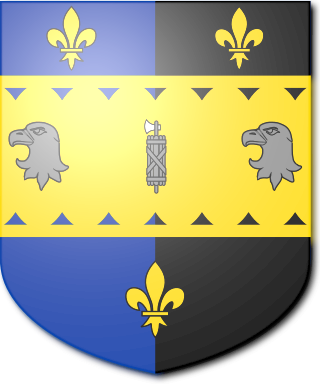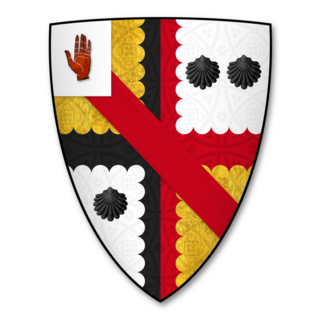
Earl of Kimberley, of Kimberley in the County of Norfolk, is a title in the Peerage of the United Kingdom. It was created in 1866 for the prominent Liberal politician John Wodehouse, 3rd Baron Wodehouse. During his long political career, he notably held office as Lord Lieutenant of Ireland, Secretary of State for the Colonies, Secretary of State for India and Secretary of State for Foreign Affairs. He was succeeded by his son, the second Earl. At first a Liberal like his father, he later joined the Labour Party, becoming the first Labour member of the House of Lords. His eldest son, the third Earl, represented Norfolk Mid in the House of Commons as a Liberal. Since 2002, the titles are held by the latter's grandson, the fifth Earl.

Viscount Hardinge, of Lahore and of Kings Newton in the County of Derby, is a title in the Peerage of the United Kingdom. It was created in 1846 for the soldier and Tory politician Sir Henry Hardinge. His son, the second Viscount, represented Downpatrick in Parliament. His great-great-grandson, the sixth Viscount, succeeded a distant relative as eighth Baronet, of Belle Isle in the County of Fermanagh, in 1986. This title had been created in the Baronetage of the United Kingdom 1801 for Richard Hardinge. He was the third son of Nicolas Hardinge, younger brother of Reverend Henry Hardinge and uncle of the latter's third son Henry Hardinge, 1st Viscount Hardinge. The baronetcy was created with special remainder to the heirs male of Richard Hardinge's father.

Baron Roborough, of Maristow in the County of Devon, is a title in the Peerage of the United Kingdom. It was created on 24 January 1938 for Sir Henry Lopes, 4th Baronet. He had earlier represented Grantham, Lincolnshire, in Parliament as a Conservative. The Baronetcy, of Maristow House in the County of Devon, had been created in the Baronetage of the United Kingdom on 1 November 1805 for Manasseh Masseh Lopes, a member of a wealthy family of Portuguese Jewish origin, with special remainder to his nephew Ralph Franco, son of his sister Maria. Manasseh Masseh Lopes converted to Christianity in 1802, and later represented Evesham, in Worcestershire, Barnstaple in Devon, and Westbury in Somerset, in Parliament. However, in 1819 he was twice convicted of bribing the voters in both Barnstaple and Grampound in order to be elected to Parliament, and was sentenced to imprisonment and heavy fines. He was also unseated by the House of Commons, but after his release from prison he nonetheless got elected for Westbury, a pocket borough which he controlled to a great extent.

Sir Ilay Campbell, 1st Baronet, Lord Succoth, (1734–1823) was a Scottish advocate, judge and politician. He rose to be Lord President of the Court of Session.

The Sitwell Baronetcy, of Renishaw in the County of Derby, is a title in the Baronetage of the United Kingdom. It was created on 3 October 1808 for Sitwell Sitwell, Member of Parliament for West Looe. The Sitwell family had been ironmasters and landowners in Eckington, Derbyshire, for many centuries.

The Whitehead Baronetcy, of Highfield House in Catford Bridge in the County of Kent, is a title in the Baronetage of the United Kingdom. It was created on 26 November 1889 for James Whitehead, Lord Mayor of London between 1888 and 1889 and later member of parliament for Leicester. His younger son, the third baronet, was also a Member of Parliament.

There have been two baronetcies created for members of the Whitmore family, one in the Baronetage of England and one in the Baronetage of the United Kingdom. One creation is extinct while the other is extant.
The Langham Baronetcy, of Cottesbrooke in the County of Northampton, is a title in the Baronetage of England. It was created on 7 June 1660 for John Langham, Member of Parliament for the City of London in 1654 and for Southwark in 1660 and 1661. The second Baronet was Member of Parliament for Northamptonshire and Northampton while the third Baronet sat for Northampton. The seventh Baronet was Member of Parliament for Northamptonshire. The tenth Baronet represented St Germans in the House of Commons. The thirteenth Baronet was a photographer, ornithologist and entomologist and served as High Sheriff of County Fermanagh in 1930.

The Medlycott Baronetcy, of Ven House in the County of Somerset, was a title in the Baronetage of the United Kingdom. It was created on 3 October 1808 for William Medlycott, Member of Parliament for Milborne Port from 1790 to 1791. The family descended from James Medlycott, of Ven House, who represented Milborne Port in the House of Commons between 1710 and 1722. His son Thomas Medlycott died without surviving male issue in 1763 and left his estates to his maternal nephew Thomas Hutchings, who adopted the surname of Medlycott. His son was the first Baronet. The baronetcy became extinct with the death of the 9th Baronet in 2021.

The Price, later Rugge-Price Baronetcy, of Spring Grove in Richmond in the County of Surrey, is a title in the Baronetage of the United Kingdom. It was created on 2 February 1804 for Charles Price, Member of Parliament for the City of London from 1802 to 1812 and Lord Mayor of London from 1802 to 1803. The fifth Baronet assumed in 1874 by Royal licence the additional surname of Rugge. As of 28 February 2014 the present Baronet has not successfully proven his succession and is therefore not on the Official Roll of the Baronetage, with the baronetcy considered dormant since 2000.

The Cotterell baronetcy, of Garnons in the County of Hereford, is a title in the Baronetage of the United Kingdom. It was created on 2 November 1805 for John Cotterell, Member of Parliament for Herefordshire for many years. The third Baronet also represented this constituency in the House of Commons. The fourth Baronet was Lord-Lieutenant of Herefordshire.

The Pigott Baronetcy, of Knapton in the Queen's County, is a title in the Baronetage of the United Kingdom. It was created on 3 October 1808, for George Pigott. Pigott was the son of Thomas Pigott, a major general in the army and Member of Parliament.
There have been three baronetcies created for personswith the surname Elphinstone, two in the Baronetage of Nova Scotia and one in the Baronetage of the United Kingdom. As of 2008 two of the creations are extant while one is dormant.
Sir Archibald Campbell of Succoth, Lord Succoth, 2nd Baronet was a Scottish advocate and judge. His country house was Garscube House, succeeding to the estate in 1823, upon his father's death. He rebuilt the house at Garscube in 1827, to a design by William Burn. He added Cumlodden, Blairwhoisk, Sommerson and Gartowhern to the family estate.
The Montgomery baronetcy, of Stanhope in the County of Peebles, was created in the Baronetage of the United Kingdom on 16 July 1801 for the Scottish lawyer and politician James Montgomery. The second Baronet represented Peeblesshire in Parliament. The third Baronet represented both Peebles and Peebles and Selkirk in Parliament. He assumed the additional surname of Graham. The seventh Baronet was Lord-Lieutenant of Kinross-shire. He assumed the surname of Purvis-Russell-Montgomery in 1906 and Purvis-Russell-Hamilton-Montgomery in 1933. The eighth and ninth Baronet have used the surname Montgomery only. The ninth Baronet was Lord-Lieutenant of Perth and Kinross.
The Montgomery baronetcy, of The Hall in the County of Donegal, was created in the Baronetage of the United Kingdom on 3 October 1808 for Conyngham Montgomery, Member of Parliament for Mitchell, Donegal and Yarmouth. The second Baronet was sworn of the Privy Council in 1876. The title became extinct on the death of the fifth Baronet in 1939.

The Lees Baronetcy, of Blackrock in the County of Dublin, was created in the Baronetage of the United Kingdom on 30 June 1804 for the soldier and politician John Lees.

The Campbell baronetcy, of Auchinbreck in the County of Argyll, was created in the Baronetage of Nova Scotia on 24 January 1628 for Sir Dugald Campbell. He was a descendant of Duncan Campbell of Kilmichael, younger son of Duncan Campbell, 1st Lord Campbell, ancestor of the Dukes of Argyll. The fifth Baronet was one of the Scottish representatives to the 1st Parliament of Great Britain.

The Campbell baronetcy, of New Brunswick, was created in the Baronetage of the United Kingdom on 30 September 1831 for Archibald Campbell, Lieutenant Governor of New Brunswick. The title became extinct on the death of the fifth Baronet in 1949.
The Mackenzie baronetcy, of Scatwell in the County of Ross, was created in the Baronetage of Nova Scotia on 22 February 1703 for Kenneth Mackenzie, who represented Ross-shire in the Scottish Parliament. He was a descendant of Kenneth Mackenzie, brother of the 1st Baronet of the 1628 creation. The 5th Baronet represented Ross-shire in the British Parliament and was Lord Lieutenant of Ross-shire.














